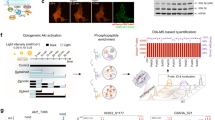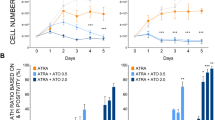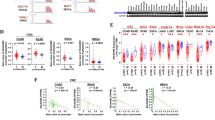Abstract
Endoplasmic reticulum (ER) stress-mediated cell death has an important role in the pathogenesis of chronic diseases, including diabetes and neurodegeneration. Although proapoptotic programs activated by ER stress have been extensively studied, identification and characterization of antiapoptotic programs that counteract ER stress are currently incomplete. Through the gene expression profiling of β-cells lacking Wolfram syndrome 1 gene (WFS1), a causative gene for Wolfram syndrome, we discovered a novel antiapoptotic gene of the unfolded protein response (UPR), apoptosis antagonizing transcription factor (AATF). Here, we study the regulation of AATF, identify its target genes, and determine the basis for its antiapoptotic activities in response to ER stress. We show that AATF is induced by ER stress through the PERK–eIF2α pathway and transcriptionally activates the v-akt murine thymoma viral oncogene homolog 1 (AKT1) gene through signal transducer and activator of transcription 3 (Stat3), which sustains Akt1 activation and promotes cell survival. Ectopic expression of AATF or a constitutively active form of AKT1 confers on cells resistance to ER stress-mediated cell death, whereas RNAi-mediated knockdown of AATF or AKT1 renders cells sensitive to ER stress. We also discovered a positive crosstalk between the AATF and WFS1 signaling pathways. Thus, WFS1 deficiency or AATF deficiency mediates a self-perpetuating cycle of cell death. Our results reveal a novel antiapoptotic program relevant to the treatment of diseases caused by ER stress-mediated cell death.
Similar content being viewed by others
Log in or create a free account to read this content
Gain free access to this article, as well as selected content from this journal and more on nature.com
or
Abbreviations
- ER stress:
-
endoplasmic reticulum stress
- UPR:
-
unfolded protein response
- AATF:
-
apoptosis antagonizing transcription factor
- WFS1:
-
Wolfram syndrome 1 gene
- AKT1:
-
v-akt murine thymoma viral oncogene homolog 1
- STAT3:
-
signal transducer and activator of transcription 3
- JNK:
-
c-Jun N-terminal kinase
- ERAD:
-
endoplasmic reticulum-associated protein degradation
References
Ron D, Walter P . Signal integration in the endoplasmic reticulum unfolded protein response. Nat Rev Mol Cell Biol 2007; 8: 519–529.
Rutkowski DT, Kaufman RJ . That which does not kill me makes me stronger: adapting to chronic ER stress. Trends Biochem Sci 2007; 32: 469–476.
Szegezdi E, Logue SE, Gorman AM, Samali A . Mediators of endoplasmic reticulum stress-induced apoptosis. EMBO Rep 2006; 7: 880–885.
Kim I, Xu W, Reed JC . Cell death and endoplasmic reticulum stress: disease relevance and therapeutic opportunities. Nat Rev 2008; 7: 1013–1030.
Zinszner H, Kuroda M, Wang X, Batchvarova N, Lightfoot RT, Remotti H et al. CHOP is implicated in programmed cell death in response to impaired function of the endoplasmic reticulum. Genes Dev 1998; 12: 982–995.
Urano F, Wang X, Bertolotti A, Zhang Y, Chung P, Harding HP et al. Coupling of stress in the ER to activation of JNK protein kinases by transmembrane protein kinase IRE1. Science 2000; 287: 664–666.
Nishitoh H, Matsuzawa A, Tobiume K, Saegusa K, Takeda K, Inoue K et al. ASK1 is essential for endoplasmic reticulum stress-induced neuronal cell death triggered by expanded polyglutamine repeats. Genes Dev 2002; 16: 1345–1355.
Eizirik DL, Cardozo AK, Cnop M . The role for endoplasmic reticulum stress in diabetes mellitus. Endocr Rev 2008; 29: 42–61.
Fonseca SG, Lipson KL, Urano F . Endoplasmic reticulum stress signaling in pancreatic beta-cells. Antioxid Redox Signal 2007; 9: 2335–2344.
Riggs AC, Bernal-Mizrachi E, Ohsugi M, Wasson J, Fatrai S, Welling C et al. Mice conditionally lacking the Wolfram gene in pancreatic islet beta cells exhibit diabetes as a result of enhanced endoplasmic reticulum stress and apoptosis. Diabetologia 2005; 48: 2313–2321.
Yamada T, Ishihara H, Tamura A, Takahashi R, Yamaguchi S, Takei D et al. WFS1-deficiency increases endoplasmic reticulum stress, impairs cell cycle progression and triggers the apoptotic pathway specifically in pancreatic beta-cells. Hum Mol Genet 2006; 15: 1600–1609.
Karasik A, O’Hara C, Srikanta S, Swift M, Soeldner JS, Kahn CR et al. Genetically programmed selective islet beta-cell loss in diabetic subjects with Wolfram’s syndrome. Diabetes Care 1989; 12: 135–138.
Inoue H, Tanizawa Y, Wasson J, Behn P, Kalidas K, Bernal-Mizrachi E et al. A gene encoding a transmembrane protein is mutated in patients with diabetes mellitus and optic atrophy (Wolfram syndrome). Nat Genet 1998; 20: 143–148.
Strom TM, Hortnagel K, Hofmann S, Gekeler F, Scharfe C, Rabl W et al. Diabetes insipidus, diabetes mellitus, optic atrophy and deafness (DIDMOAD) caused by mutations in a novel gene (wolframin) coding for a predicted transmembrane protein. Hum Mol Genet 1998; 7: 2021–2028.
Fonseca SG, Fukuma M, Lipson KL, Nguyen LX, Allen JR, Oka Y et al. WFS1 is a novel component of the unfolded protein response and maintains homeostasis of the endoplasmic reticulum in pancreatic {beta}-cells. J Biol Chem 2005; 280: 39609–39615.
Page G, Lodige I, Kogel D, Scheidtmann KH . AATF, a novel transcription factor that interacts with Dlk/ZIP kinase and interferes with apoptosis. FEBS Lett 1999; 462: 187–191.
Bruno T, De Angelis R, De Nicola F, Barbato C, Di Padova M, Corbi N et al. Che-1 affects cell growth by interfering with the recruitment of HDAC1 by Rb. Cancer Cell 2002; 2: 387–399.
Fanciulli M, Bruno T, Di Padova M, De Angelis R, Iezzi S, Iacobini C et al. Identification of a novel partner of RNA polymerase II subunit 11, Che-1, which interacts with and affects the growth suppression function of Rb. FASEB J 2000; 14: 904–912.
Harding HP, Novoa I, Zhang Y, Zeng H, Wek R, Schapira M et al. Regulated translation initiation controls stress-induced gene expression in mammalian cells. Mol Cell 2000; 6: 1099–1108.
Harding HP, Zhang Y, Ron D . Protein translation and folding are coupled by an endoplasmic-reticulum-resident kinase. Nature 1999; 397: 271–274.
Boyce M, Bryant KF, Jousse C, Long K, Harding HP, Scheuner D et al. A selective inhibitor of eIF2alpha dephosphorylation protects cells from ER stress. Science 2005; 307: 935–939.
Kozutsumi Y, Segal M, Normington K, Gething MJ, Sambrook J . The presence of malfolded proteins in the endoplasmic reticulum signals the induction of glucose-regulated proteins. Nature 1988; 332: 462–464.
Franke TF . PI3K/Akt: getting it right matters. Oncogene 2008; 27: 6473–6488.
Amaravadi R, Thompson CB . The survival kinases Akt and Pim as potential pharmacological targets. J Clin Invest 2005; 115: 2618–2624.
Srinivasan S, Ohsugi M, Liu Z, Fatrai S, Bernal-Mizrachi E, Permutt MA . Endoplasmic reticulum stress-induced apoptosis is partly mediated by reduced insulin signaling through phosphatidylinositol 3-kinase/Akt and increased glycogen synthase kinase-3beta in mouse insulinoma cells. Diabetes 2005; 54: 968–975.
Hu P, Han Z, Couvillon AD, Exton JH . Critical role of endogenous Akt/IAPs and MEK1/ERK pathways in counteracting endoplasmic reticulum stress-induced cell death. J Biol Chem 2004; 279: 49420–49429.
Park S, Kim D, Kaneko S, Szewczyk KM, Nicosia SV, Yu H et al. Molecular cloning and characterization of the human AKT1 promoter uncovers its up-regulation by the Src/Stat3 pathway. J Biol Chem 2005; 280: 38932–38941.
Xu Q, Briggs J, Park S, Niu G, Kortylewski M, Zhang S et al. Targeting Stat3 blocks both HIF-1 and VEGF expression induced by multiple oncogenic growth signaling pathways. Oncogene 2005; 24: 5552–5560.
Kakiuchi C, Ishigaki S, Oslowski CM, Fonseca SG, Kato T, Urano F . Valproate, a mood stabilizer, induces WFS1 expression and modulates its interaction with ER stress protein GRP94. PLoS ONE 2009; 4: e4134.
Kakiuchi C, Ishiwata M, Hayashi A, Kato T . XBP1 induces WFS1 through an endoplasmic reticulum stress response element-like motif in SH-SY5Y cells. J Neurochem 2006; 97: 545–555.
Bruno T, De Nicola F, Iezzi S, Lecis D, D’Angelo C, Di Padova M et al. Che-1 phosphorylation by ATM/ATR and Chk2 kinases activates p53 transcription and the G2/M checkpoint. Cancer Cell 2006; 10: 473–486.
Bruno T, Iezzi S, De Nicola F, Di Padova M, Desantis A, Scarsella M et al. Che-1 activates XIAP expression in response to DNA damage. Cell Death Differ 2008; 15: 515–520.
Puthalakath H, O’Reilly LA, Gunn P, Lee L, Kelly PN, Huntington ND et al. ER stress triggers apoptosis by activating BH3-only protein Bim. Cell 2007; 129: 1337–1349.
Reimertz C, Kogel D, Rami A, Chittenden T, Prehn JH . Gene expression during ER stress-induced apoptosis in neurons: induction of the BH3-only protein Bbc3/PUMA and activation of the mitochondrial apoptosis pathway. J Cell Biol 2003; 162: 587–597.
Sugatani T, Hruska KA . Akt1/Akt2 and mammalian target of rapamycin/Bim play critical roles in osteoclast differentiation and survival, respectively, whereas Akt is dispensable for cell survival in isolated osteoclast precursors. J Biol Chem 2005; 280: 3583–3589.
Karst AM, Dai DL, Cheng JQ, Li G . Role of p53 up-regulated modulator of apoptosis and phosphorylated Akt in melanoma cell growth, apoptosis, and patient survival. Cancer Res 2006; 66: 9221–9226.
Marciniak SJ, Ron D . Endoplasmic reticulum stress signaling in disease. Physiol Rev 2006; 86: 1133–1149.
Yamamoto K, Sato T, Matsui T, Sato M, Okada T, Yoshida H et al. Transcriptional induction of mammalian ER quality control proteins is mediated by single or combined action of ATF6alpha and XBP1. Dev Cell 2007; 13: 365–376.
Lipson KL, Fonseca SG, Urano F . Endoplasmic reticulum stress-induced apoptosis and auto-immunity in diabetes. Curr Mol Med 2006; 6: 71–77.
Irizarry RA, Hobbs B, Collin F, Beazer-Barclay YD, Antonellis KJ, Scherf U et al. Exploration, normalization, and summaries of high density oligonucleotide array probe level data. Biostatistics 2003; 4: 249–264.
Irizarry RA, Bolstad BM, Collin F, Cope LM, Hobbs B, Speed TP . Summaries of Affymetrix GeneChip probe level data. Nucleic Acids Res 2003; 31: e15.
Smyth GK . Linear models and empirical bayes methods for assessing differential expression in microarray experiments. Stat Appl Genet Mol Biol 2004; 3: Article3.
Benjamini Y, Hochberg Y . Controlling the false discovery rate: a practical and powerful approach to multiple testing. J R Statist Soc B 1995; 57: 289–300.
Campeau E, Ruhl VE, Rodier F, Smith CL, Rahmberg BL, Fuss JO et al. A versatile viral system for expression and depletion of proteins in mammalian cells. PLoS ONE 2009; 4: e6529.
Bromberg JF, Wrzeszczynska MH, Devgan G, Zhao Y, Pestell RG, Albanese C et al. Stat3 as an oncogene. Cell 1999; 98: 295–303.
Ohkawa Y, Marfella CG, Imbalzano AN . Skeletal muscle specification by myogenin and Mef2D via the SWI/SNF ATPase Brg1. EMBO J 2006; 25: 490–501.
Freeman MF, Tukey JW . Transformations related to the angular, and the square root. Ann Mathem Stat 1950; 21: 607–611.
Acknowledgements
We thank E Campeau for providing lentiviral expression systems; MR Green, KL Lipson, C Kakiuchi, R Ghosh, and Y Okawa for helpful discussions; K Sargent and L Leehy for technical assistance. Research in the laboratory of F Urano was supported by an NIH R01DK067493 grant, a grant from the Diabetes and Endocrinology Research Center at the University of Massachusetts Medical School (DK032520), a Juvenile Diabetes Research Foundation Regular Grant, and an Iacocca Foundation/Juvenile Diabetes Research Foundation joint grant.
Author information
Authors and Affiliations
Corresponding authors
Ethics declarations
Competing interests
The authors declare no conflict of interest.
Additional information
Edited by S Kumar
Supplementary Information accompanies the paper on Cell Death and Differentiation website
Supplementary information
Rights and permissions
About this article
Cite this article
Ishigaki, S., Fonseca, S., Oslowski, C. et al. AATF mediates an antiapoptotic effect of the unfolded protein response through transcriptional regulation of AKT1. Cell Death Differ 17, 774–786 (2010). https://doi.org/10.1038/cdd.2009.175
Received:
Revised:
Accepted:
Published:
Issue date:
DOI: https://doi.org/10.1038/cdd.2009.175
Keywords
This article is cited by
-
Live and let die: signaling AKTivation and UPRegulation dynamics in SARS-CoVs infection and cancer
Cell Death & Disease (2022)
-
CK2-mediated phosphorylation of Che-1/AATF is required for its pro-proliferative activity
Journal of Experimental & Clinical Cancer Research (2021)
-
MicroRNA-663 antagonizes apoptosis antagonizing transcription factor to induce apoptosis in epithelial cells
Apoptosis (2019)
-
A protein-RNA interaction atlas of the ribosome biogenesis factor AATF
Scientific Reports (2019)
-
eEF1Bγ binds the Che-1 and TP53 gene promoters and their transcripts
Journal of Experimental & Clinical Cancer Research (2016)



